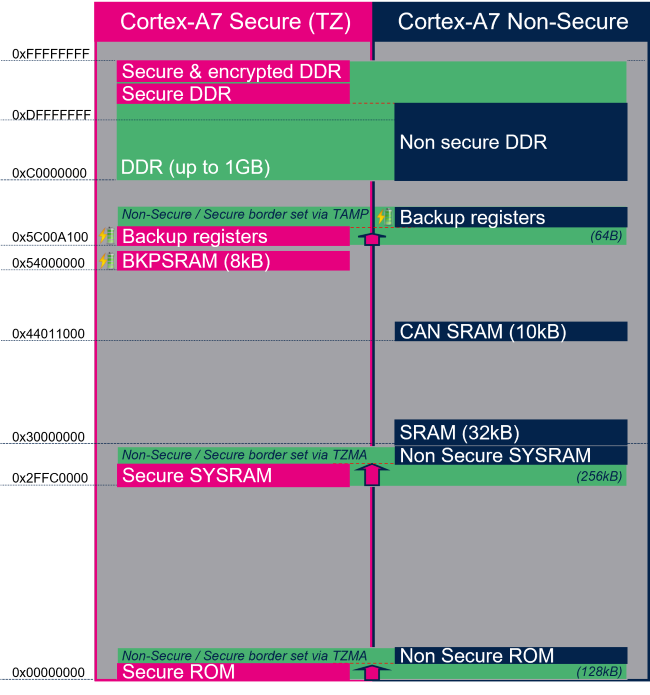This article describes how the STM32 MPU Embedded Software distribution maps the various software memory needs in internal and external volatile memories.
1. Overview[edit | edit source]
This article shows the default memory mapping defined by STMicroelectronics in STM32MPU Embedded Software. It uses a subset of all memory regions that are exposed at hardware level: customers may use other memory regions or aliases that are not shown here but are described in the STM32MP13 reference manuals.
2. Arm core characteristics[edit | edit source]
The integration of Arm® Cortex® cores sets some constraints on the device memory mapping: the main ones are listed in this article.
2.1. Reset address[edit | edit source]
Arm® Cortex® cores start running from address 0x00000000 on reset, which is why this address respectively points to:
- The ROM code on the Arm® Cortex® side. This read-only memory embeds the boot code that is executed when the platform boots (and executes the boot chain) or wakes up from low power STANDBY mode.
3. Memory mapping[edit | edit source]
3.1. Overall memory mapping[edit | edit source]
The memory mapping below is a subset of all regions that are exposed at hardware level: it shows the default configuration used in OpenSTLinux but the customer may choose a different mapping to take advantage of other address ranges defined in STM32MP13 reference manuals.

4. Internal RAM mapping[edit | edit source]
4.1. Overview[edit | edit source]
SYSRAM and SRAM can be used by secure and non-secure Arm® Cortex® contexts as described in SYSRAM internal memory and STM32MP13 SRAM internal memory articles.
- 124kB Secure region dedicated to OP-TEE mainly for secure monitor services.
SYSRAM is split in two parts:
- 4kB non-secure region dedicated to SCMI shared memory for message exchange between OP-TEE and non-secure firmware
4.2. How to configure Internal RAM mapping[edit | edit source]
The memory usage is defined in both Arm® Cortex® contexts:
- on secure Arm® Cortex®-A7: in OP-TEE device tree, using Reserved_memory mechanism
- on non-secure Arm® Cortex®-A7: in Linux® device tree, using Reserved_memory mechanism
To ensure the consistency of the system, both memory declarations have to be updated according to the expected configuration.
4.2.1. SRAM[edit | edit source]
By default part of the SRAM is reserved for DMA chaining for Linux® features. It can be freed for some other purposes by removing the following declarations in Linux® device tree :
&sram {
dma_pool: dma_pool@0 {
reg = <0x0 0x4000>;
pool;
};
&dma1 {
sram = <&dma_pool>;
};
&dma2 {
sram = <&dma_pool>;
};
5. DDR mapping[edit | edit source]
| Coming soon |